
This page is part of © FOTW Flags Of The World website
Mail dispatch signal flags in Cabo Verde, 1889-1891
Last modified: 2022-10-14 by antónio martins
Keywords: mail flag |
Links: FOTW homepage |
search |
disclaimer and copyright |
write us |
mirrors
- Presentation
- Cabo Verde islands: triangular
- remote/foreign parts: rectangular
See also:
External links:
Presentation
This system was created in 1889 and lasted for two years. Signal flags
were used ashore in post offices to indicate the origin and destination of
the next mail ship. When a post office was engaged in dispatching, one or
several of these flags would be hoisted (the one at the top being the first
to be closed and shipped), half masted when the bag was about to be
closed.
António Martins, 06 Jul 2017
These mailbag flags are all very simple in design, as befits signal
flags, with some being plain colored and the rest divided into two areas
by a vertical division offset from the hoist slightly less than the half
of the flag’s width. In the
source
chart (apparently a secondary source, dated “posthumusly”
of 1891, not an original legal instrument), the ratio of these flags,
regardless of shape, is ~5:8.
António Martins, 06 Jul 2017
There are two types of flag in this set:
- Nine rectangular flags standing for remote/foreign parts, and eight
triangular flags standing for Cabo Verde islands (yes, two islands
missing). The general pattern seems to be of plain flags for the
Barlavento islands and vertically split flags
with white fly for the Sotavento islands (with
plain white Brava being an exception).
- The remote/foreign parts, mostly countries (although more likely meant
to represent one or selected few harbours in each of them) are
symbolized by rectangular flags ~2:3, plain or vertically bicolored.
Some of these flags present, in this limited pattern, a simplification
of the correspondent contemporary national flag.
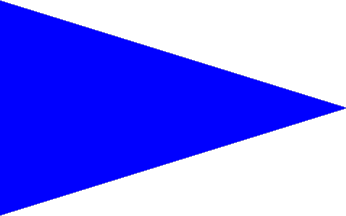 Santo Antão: plain blue triangular flag
Santo Antão: plain blue triangular flag São Vicente (and Santa Luzia): no flag
São Vicente (and Santa Luzia): no flag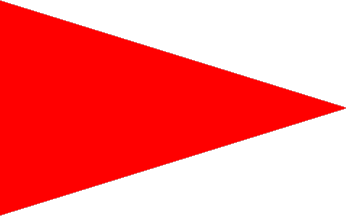 São Nicolau: plain red triangular flag
São Nicolau: plain red triangular flag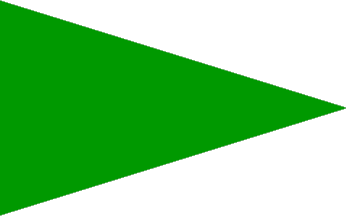 Sal: plain green triangular flag
Sal: plain green triangular flag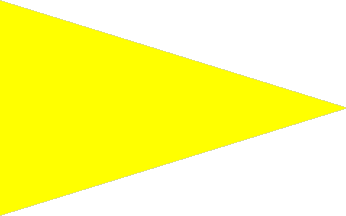 Boavista: plain yellow triangular flag
Boavista: plain yellow triangular flag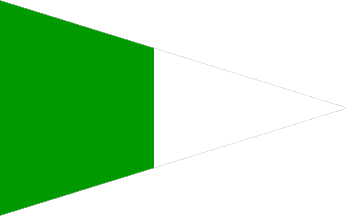 Maio: green and white triangular vertical
bicolor
Maio: green and white triangular vertical
bicolor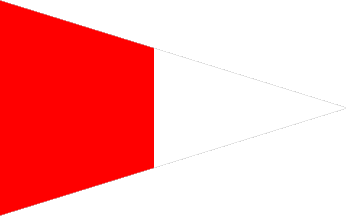 Praia: red and white triangular
vertical bicolor
Praia: red and white triangular
vertical bicolor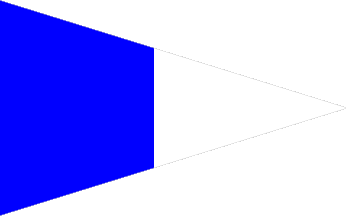 Fogo: blue and white triangular vertical
bicolor
Fogo: blue and white triangular vertical
bicolor Brava: plain white triangular flag
Brava: plain white triangular flag | |
For most of these (maybe for all) in practice only a single destination
port was meant, not any of several locations on the same local island or
remote country (or other named territory).
António Martins, 06 Jul 2017 and 07 Jul 2017
Therefore, yes, there are island flags
in Cabo Verde, sort of. Or there were, in the late 19th century: Not as
tokens of local government of any sort, but rather signal flags. Curiously,
the flag respresenting any given island could therefore be hoisted at
anywhere else in Cabo Verde except on the represented island
itself…
António Martins, 06 Jul 2017
(This kind of signal flags representing origin, destination, and/or
registration ports, prosaic and ad hoc as they are, formed the
basis for several subnational (any national?) flags worldwide —
notably that of Galicia, from the
Corunna maritime province ensign.)
António Martins, 06 Jul 2017
Having lasted only two years in legal validity (and maybe even
less in practice), this system seems to have left no marks in local
emblematics.
António Martins, 06 Jul 2017
Santo Antão
![[flag]](../images/c/cv~89-1.gif)
António Martins, 06 Jul 2017
Signal flag legislated to be hoisted on Cabo Verde post offices
in 1889-1891 to indicate outgoing and arriving mail ships to/from
Santo Antão island: Plain blue triangular
flag.
António Martins, 06 Jul 2017
São Vicente (and Santa Luzia)
The two missing islands are the (then) sparsely inhabited Santa Luzia
and São Vicente. (I have no idea how their mail was routed —
perhaps via São Nicolau or Santo Antão.)
António Martins, 06 Jul 2017
São Nicolau
![[flag]](../images/c/cv~89-3.gif)
António Martins, 06 Jul 2017
Signal flag legislated to be hoisted on Cabo Verde post offices in
1889-1891 to indicate outgoing and arriving mail ships to/from
São Nicolau island: Plain red triangular
flag.
António Martins, 06 Jul 2017
Sal
![[flag]](../images/c/cv~89-4.gif)
António Martins, 06 Jul 2017
Signal flag legislated to be hoisted on Cabo Verde post offices in
1889-1891 to indicate outgoing and arriving mail ships to/from
Sal island: Plain green triangular flag.
António Martins, 06 Jul 2017
Boavista
![[flag]](../images/c/cv~89-5.gif)
António Martins, 06 Jul 2017
Signal flag legislated to be hoisted on Cabo Verde post offices in
1889-1891 to indicate outgoing and arriving mail ships to/from
Boavista island: Plain yellow triangular flag.
António Martins, 06 Jul 2017
Maio
![[flag]](../images/c/cv~89-6.gif)
António Martins, 06 Jul 2017
Signal flag legislated to be hoisted on Cabo Verde post offices in
1889-1891 to indicate outgoing and arriving mail ships to/from
Maio island:
Green and white triangular vertical bicolor.
António Martins, 06 Jul 2017
Praia
![[flag]](../images/c/cv~89-7.gif)
António Martins, 06 Jul 2017
Signal flag legislated to be hoisted on Cabo Verde post offices in
1889-1891 to indicate outgoing and arriving mail ships to/from
Praia (sic): Red and white triangular
vertical bicolor. Here Praia, the capital of
the colony, is refered to instead of the
Island of Santiago, unlike for the other flags,
even though for most of them (or even for all) in practice only a single
destination port was meant, not any of several locations on the same
island.
António Martins, 06 Jul 2017
Fogo
![[flag]](../images/c/cv~89-8.gif)
António Martins, 06 Jul 2017
Signal flag legislated to be hoisted on Cabo Verde post offices in
1889-1891 to indicate outgoing and arriving mail ships to/from
Fogo island:
Blue and white triangular vertical bicolor.
António Martins, 06 Jul 2017
Brava
![[flag]](../images/c/cv~89-9.gif)
António Martins, 06 Jul 2017
Signal flag legislated to be hoisted on Cabo Verde post offices in
1889-1891 to indicate outgoing and arriving mail ships to/from
Brava island: Plain white triangular flag.
This is an exception to the general pattern of plain flags for the
Barlavento islands and vertically split flags
with white fly for the Sotavento islands.
António Martins, 06 Jul 2017
Portugal
![[flag]](../images/c/cv~89pt.gif)
António Martins, 07 Jul 2017
Signal flag legislated to be hoisted on Cabo Verde post offices in
1889-1891 to indicate outgoing and arriving mail ships to/from
Portugal (sic — meaning the mainland):
A blue and white unequal bicolor, certainly meant as a simplification
of the contemporary national flag, whose
background is this very pattern.
António Martins, 06 Jul 2017 and 07 Jul 2017
Brazil
![[flag]](../images/c/cv~89br.gif)
António Martins, 07 Jul 2017
Signal flag legislated to be hoisted on Cabo Verde post offices in
1889-1891 to indicate outgoing and arriving mail ships to/from
Brazil:
A plain green flag, likely meant as a drastic simplification of the
contemporary national flags (both Imperial, up
to Nov. 1889, and Republican, afterwards),
which do feature a plain green background.
António Martins, 06 Jul 2017 and 07 Jul 2017
Spain
![[flag]](../images/c/cv~89es.gif)
António Martins, 07 Jul 2017
Signal flag legislated to be hoisted on Cabo Verde post offices in
1889-1891 to indicate outgoing and arriving mail ships to/from
Spain:
A red and yellow unequal bicolor, possibly meant as a reminder of the
contemporary national flag, which was red and
yellow, or perhaps the civil ensign, in the
same colors but with predominant yellow.
António Martins, 06 Jul 2017 and 07 Jul 2017
France
![[flag]](../images/c/cv~89fr.gif)
António Martins, 07 Jul 2017
Signal flag legislated to be hoisted on Cabo Verde post offices in
1889-1891 to indicate outgoing and arriving mail ships to/from
France:
A blue and red unequal bicolor, possibly meant as a reminder of the
contemporary national flag, or perhaps a nod
to its historical origin, the
Paris bicolor flag.
António Martins, 06 Jul 2017 and 07 Jul 2017
Italy
![[flag]](../images/c/cv~89it.gif)
António Martins, 07 Jul 2017
Signal flag legislated to be hoisted on Cabo Verde post offices in
1889-1891 to indicate outgoing and arriving mail ships to/from
Italy:
A green and white unequal bicolor, possibly meant as a reminder of the
contemporary national flag.
António Martins, 06 Jul 2017 and 07 Jul 2017
England
![[flag]](../images/c/cv~89gb.gif)
António Martins, 07 Jul 2017
Signal flag legislated to be hoisted on Cabo Verde post offices in
1889-1891 to indicate outgoing and arriving mail ships to/from
England (sic):
A plain red flag, possibly meant as a reminder of the
British red ensign, probably also based on the
habitual use of red to symbolize the United Kingdom (or, in maps, of
pink).
António Martins, 06 Jul 2017 and 07 Jul 2017
South Africa
![[flag]](../images/c/cv~89za.gif)
António Martins, 07 Jul 2017
Signal flag legislated to be hoisted on Cabo Verde post offices in
1889-1891 to indicate outgoing and arriving mail ships to/from
South Africa (sic):
A plain blue flag, probably meant to represent Cape Town (the country
named Union of South Africa would be created only in 1910, after these
flags were adopted), possibly meant as a reminder of the
Cape Colony blue ensign.
António Martins, 06 Jul 2017 and 07 Jul 2017
River Plate
![[flag]](../images/c/cv~89xl.gif)
António Martins, 07 Jul 2017
Signal flag legislated to be hoisted on Cabo Verde post offices in
1889-1891 to indicate outgoing and arriving mail ships to/from
River Plate:
A plain white flag, probably meant to represent Montevideo and Buenos
Aires, its color perhaps inspired not in any national or other flags but
as a heraldic pun, with plain white meaning silver = prata (akin
to Spanish plata, thence English plate).
António Martins, 06 Jul 2017 and 07 Jul 2017
Madeira
![[flag]](../images/c/cv~89ptm.gif)
António Martins, 07 Jul 2017
Signal flag legislated to be hoisted on Cabo Verde post offices in
1889-1891 to indicate outgoing and arriving mail ships to/from
Madeira:
A red and white unequal bicolor, this flag needed to differentiate
ships sailing to/from Funchal from those bound
directly to the Portuguese mainland; I have no idea why this color pattern
was chosen — maybe just as a matter of using up available
combinations (which can also be said of other flags of this set).
António Martins, 06 Jul 2017 and 07 Jul 2017
Anything below
this line was not added by the editor of this page.
 Santo Antão: plain blue triangular flag
Santo Antão: plain blue triangular flag São Vicente (and Santa Luzia): no flag
São Vicente (and Santa Luzia): no flag São Nicolau: plain red triangular flag
São Nicolau: plain red triangular flag Sal: plain green triangular flag
Sal: plain green triangular flag Boavista: plain yellow triangular flag
Boavista: plain yellow triangular flag Maio: green and white triangular vertical
bicolor
Maio: green and white triangular vertical
bicolor Praia: red and white triangular
vertical bicolor
Praia: red and white triangular
vertical bicolor Fogo: blue and white triangular vertical
bicolor
Fogo: blue and white triangular vertical
bicolor Brava: plain white triangular flag
Brava: plain white triangular flag Portugal: blue and white unequal bicolor
Portugal: blue and white unequal bicolor Brazil: plain green flag
Brazil: plain green flag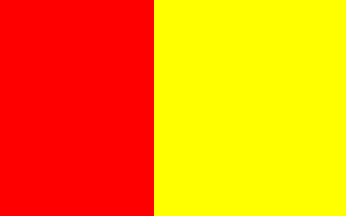 Spain: red and yellow unequal bicolor
Spain: red and yellow unequal bicolor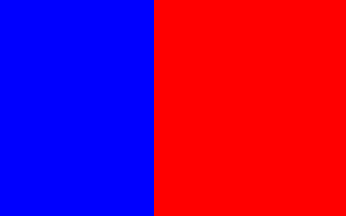 France: blue and red unequal bicolor
France: blue and red unequal bicolor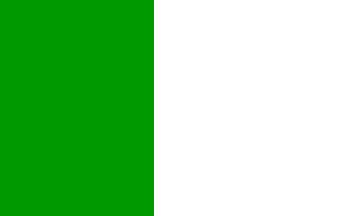 Italy: green and white unequal bicolor
Italy: green and white unequal bicolor England: plain red flag
England: plain red flag South Africa: plain blue flag
South Africa: plain blue flag River Plate: plain white flag
River Plate: plain white flag Madeira: red and white unequal
bicolor
Madeira: red and white unequal
bicolor